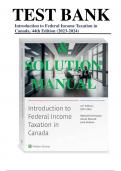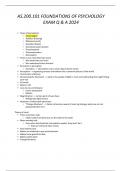Introduction to Federal Income Taxation in Canada, 44th Edition (2023 -2024) TEST BANK & SOLUTION MANUAL MEDCONNOISSEUR Stuvia.com - The Marketplace to Buy and Sell your Study Material CHAPTER 1 Introduction Solution 1: Identify section of the Act The following summary is discussed in more detail below: Case Topic Part Division Subdivision Provision (A) Person ..................................................... XVII — — subsection 248(1) (B) Donation by individual............................ I E a subsection 118.1(3) (C) Balance- due day...................................... XVII — — subsection 248(1) (D) Life insurance premiums......................... I B a subsection 6(4) (E) Capital dividend ...................................... I B h subsection 83(2) (F) Income tax instalments for individual ..... I I — subsection 156(1) (G) Qualified small business corporation share I C — subsection 110.6(1) (H) Information return for dividends ............. — — — Reg. Part II, paragraph 201(1)( a) (I) Definition of testamentary trust. ............. I B k subsection 108(1) (J) Employee loan. ....................................... I B f subsection 80.4(1) (K) Disposition of non-depreciable capital property........................................... ........ XVII — — subsection 248(1) (L) RRSP administration fees. ...................... I B b paragraph 18(1)( u) (M) Limit on deductible expenses.................. I B f section 67 (N) Taxable dividends received by Canadian corporation .............................................. I C — subsection 112(1) (O) RRSP excess contributions ..................... X.I — — subsection 204.1(1) (A) Person — Part XVII, subsection 248(1): The term is used throughout the Act, so it is likely to be found in the interpretation section. The definition is similar to many in the Act in that it does not tell you exactly what a person is; it tells you what a person includes. (B) Donation by an individual — Part I, Division E, Subdivision a, subsection 118.1(3): Tax credits are found in Division E. Credits that are particular to individuals are found in Subdivision a of Division E. (C) Balance- due day — Part XVII, subsection 248(1): The term has application to all tax filers and, therefore, should be found in the interpretation section. However, the term has a different meaning dependin g on the type of tax filer. For trusts and individuals, specific timing is provided. For cor porations, the provision refers to section 157. (D) Group term life insurance premiums paid by employer — Part I, Division B, Subdivision a, subsection 6(4): Payments made on behalf of an employee by an employer lik ely result in income from employment. Subdivision a includes the provisions for calculating income fr om employment. (E) Capital dividend — Part XVII, subsection 248(1): The term is found in subsection 248(1) but a definition is not actually provided, only a reference. It refers to another section — Part I, Division B, Subdivision h, subsection 83(2): Capital dividends are tax-free distributions by a corporation to its shareholders, so the provision is likely to be found in Part I, Division B, Subdivision h that deals with corpo rations and their shareholders. (F) Income tax instalments for an individual — Part I, Division I, subsection 156(1): The information that is required deals with payments to the CRA; therefore this information should be fo und in Division I dealing with returns, assessments, payment and appeals. [Some students may also identify subsectio n 155(1) as dealing with farmers and fishermen.] (G) Qualified small business corporation share — Part I, Division C, subsection 110.6(1): The capital gains deduction that is available for qualified small business corporation shares is a dedu ction that is available in computing taxable income and is therefore found in Division C. 1 Stuvia.com - The Marketplace to Buy and Sell your Study Material
Downloaded by: destine465 | destine465@gmail.com
Distribution of this document is illegalWant to earn $1.236 extra per year? Medconnoisseurlibraries.com
Page 1 of 1507MEDCONNOISSEUR Stuvia.com - The Marketplace to Buy and Sell your Study Material
2 Introduction to Federal Income Taxation in Canada (H) Filing information return for dividends paid — Regulations Part II, subsection 201(1): The Regulations provide important detail regarding a number of the income tax rules. In order to ensure that individuals are advised of the information required to be reported on their personal tax return s (and to allow the CRA to ensure that the income is reported), corporations are required to file slips such as T5s for dividends paid. (I) Testamentary trust — Part I, Division B, Subdivision k, subsection 108(1): The phrase describes a trust so it is likely that the definition will be found in Subdivision k dealing with trus ts. Section 108 contains definitions for the subdivision. (J) Interest-free loan benefit — Part I, Division B, Subdivision f, subsection 80.4(1): Since the amount relates to an employee, it might be expected that the provision would be found in sectio n 6 (in fact the provision that requires an income inclusion is found in subsection 6(9)). However, the actual calculation of the amount of income is found in Subdivision f which contains rules related to the calculation of incom e. (K) Disposition of non-depreciable capital property — Part XVII, subsection 248(1): The term “disposition” is used throughout the Act, so it is likely to be found in this definition section. (L) Limit on deduction of RRSP administration fees — Part I, Division B, Subdivision b, paragraph 18(1)( u): At one time, when the fees were deductible, they were considered a carrying charge deduct ible in computing income from property. Therefore, the restriction on the deduction is found in section 18 which provides a list of items that are specifically not deductible in computing income from business or proper ty. (M) Limit on deductible expenses — Part I, Division B, Subdivision f, section 67: The restriction on the amount of deductible expenses applies throughout the Act. Therefore, the provision is found in general rules for computing income that are found in Subdivision f. (N) Corporate dividend deduction — Part I, Division C, subsection 112(1): The concept deals with a deduction that is available to a corporation. It might be expected to be found in Division B, Subdivision b dealing with the calculation of income from property. However, in this case, the deduction is not considered to reduce income from property but is a general deduction available in computing taxable income. (O) Excess RRSP contributions — Part X.I, subsection 204.1(1): This is a special tax that is found in the Act and applies when an individual has contributed more to an RRSP than is allowed by the Act. In this case, the special tax is intended to discourage people from taking advantage of the benef its of an RRSP beyond those that are provided for in the rules. Stuvia.com - The Marketplace to Buy and Sell your Study Material
Downloaded by: destine465 | destine465@gmail.com
Distribution of this document is illegalWant to earn $1.236 extra per year? Medconnoisseurlibraries.com
Page 2 of 1507MEDCONNOISSEUR Stuvia.com - The Marketplace to Buy and Sell your Study Material
Solutions to Chapter 1 Assignment Problems 3 Solution 2: Determine Income Using Ordering Rules [Note to instructors changes to this problem from the prior year include: Employment Income increased from $72,600 to $78,400; Business loss increased from 4275 to $400] Division B — Sec. 3 Par. 3(a) Subdivision a Sec. 5, 6, 7, 8 Employment income ...................................................... $ $ 78,400 Subdivision b Sec. 9 Property income...................................... ......................... $ 775 Sec. 9 Rental property income................................. ................... 975 1,750 Subdivision d: Miscellaneous sources Par. 56(1)( a) Employment insurance.................................. ................... $ 600 Par. 56(1)( a) Retiring allowance ........................................................... 800 1,400 $ 81,550 Par. 3(b) Subdivision c: Net taxable capital gains Par. 38 Taxable capital gains (net of allowable capital losses)..... 100 $ 81,650 Par. 3(c) Subdivision e: Miscellaneous deductions Sec. 62 Moving expense.................................... ........................... $ 1,700 Sec. 63 Child care expense ........................................................... 1,800 CPP enhanced deduction 631 (4,131) Par. 3(d) Losses from non-capital sources: $ 77,519 Sec. 9 Business loss..................................... ........................... (400) Division B income ....................................................................................... $ 77,119 Division C: Deductions — Sec 111.1 Par. 111(1)( a) Non-capital losses ................................................................................ (600) Taxable income ........................................................................................................................................ $ 76,519 Division E: Basic federal tax — Sec. 118.92 Tax before credits ....................................................................................................................... $ 12,752 Sec. 118 Personal credits..................................... ................................................... ............. (2,250) Sec. 118.7 CPP contribution credit ....................................................................................... (469) Sec. 118.7 EI premium credit ................................................................................................ (150) Ssec. 118(10) Canada Employment tax credit ............................................................................ (205) Sec. 118.2 Medical expense credit ......................................................................................... (9) Sec. 118.1 Charitable donations credit ........................................................................................ (26) Basic federal tax........................................ ................................................... ............................... $ 9,643 Stuvia.com - The Marketplace to Buy and Sell your Study Material
Downloaded by: destine465 | destine465@gmail.com
Distribution of this document is illegalWant to earn $1.236 extra per year? Medconnoisseurlibraries.com
Page 3 of 1507MEDCONNOISSEUR





